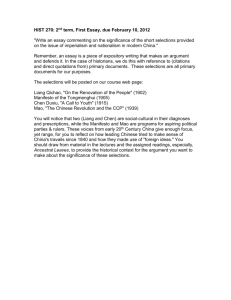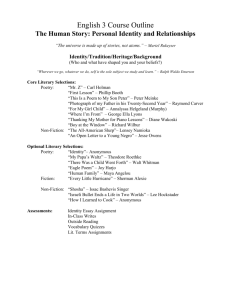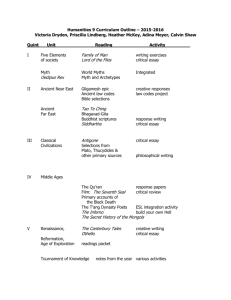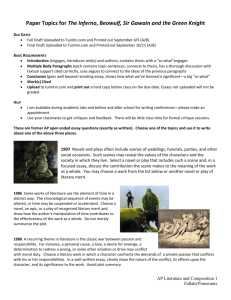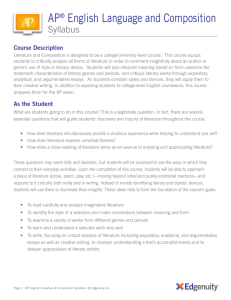hold on, it`s gonna be a wild ride! THE BLOCK AP LITERATURE
advertisement
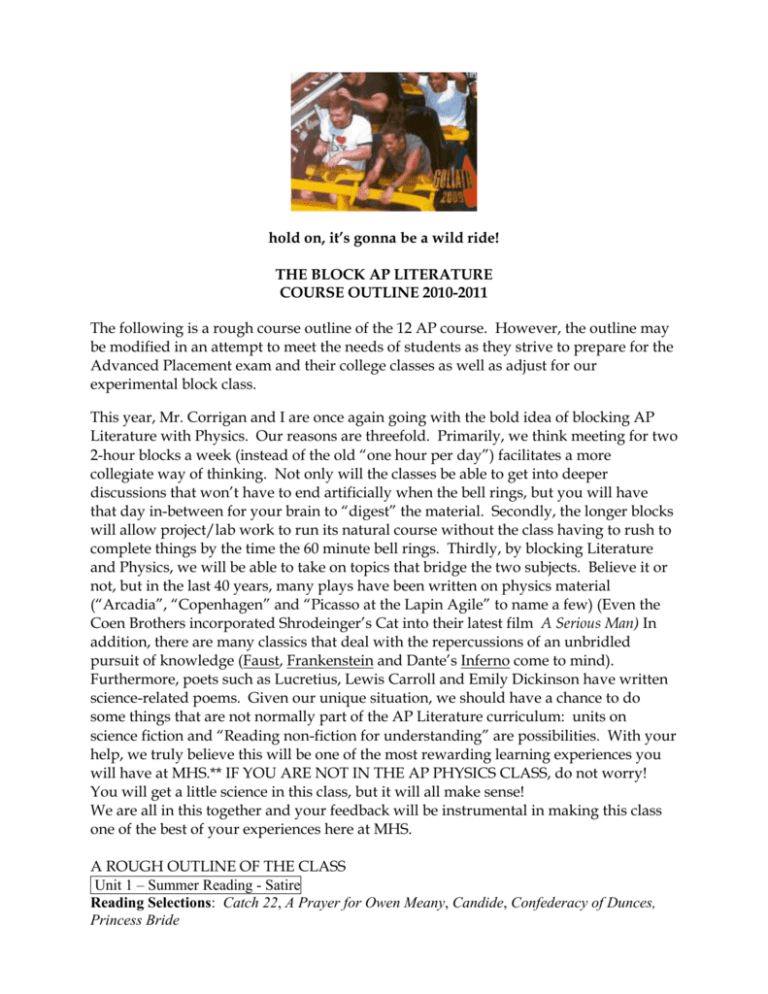
hold on, it’s gonna be a wild ride! THE BLOCK AP LITERATURE COURSE OUTLINE 2010-2011 The following is a rough course outline of the 12 AP course. However, the outline may be modified in an attempt to meet the needs of students as they strive to prepare for the Advanced Placement exam and their college classes as well as adjust for our experimental block class. This year, Mr. Corrigan and I are once again going with the bold idea of blocking AP Literature with Physics. Our reasons are threefold. Primarily, we think meeting for two 2-hour blocks a week (instead of the old “one hour per day”) facilitates a more collegiate way of thinking. Not only will the classes be able to get into deeper discussions that won’t have to end artificially when the bell rings, but you will have that day in-between for your brain to “digest” the material. Secondly, the longer blocks will allow project/lab work to run its natural course without the class having to rush to complete things by the time the 60 minute bell rings. Thirdly, by blocking Literature and Physics, we will be able to take on topics that bridge the two subjects. Believe it or not, but in the last 40 years, many plays have been written on physics material (“Arcadia”, “Copenhagen” and “Picasso at the Lapin Agile” to name a few) (Even the Coen Brothers incorporated Shrodeinger’s Cat into their latest film A Serious Man) In addition, there are many classics that deal with the repercussions of an unbridled pursuit of knowledge (Faust, Frankenstein and Dante’s Inferno come to mind). Furthermore, poets such as Lucretius, Lewis Carroll and Emily Dickinson have written science-related poems. Given our unique situation, we should have a chance to do some things that are not normally part of the AP Literature curriculum: units on science fiction and “Reading non-fiction for understanding” are possibilities. With your help, we truly believe this will be one of the most rewarding learning experiences you will have at MHS.** IF YOU ARE NOT IN THE AP PHYSICS CLASS, do not worry! You will get a little science in this class, but it will all make sense! We are all in this together and your feedback will be instrumental in making this class one of the best of your experiences here at MHS. A ROUGH OUTLINE OF THE CLASS Unit 1 – Summer Reading - Satire Reading Selections: Catch 22, A Prayer for Owen Meany, Candide, Confederacy of Dunces, Princess Bride “The Theology of Earthquakes” selection from Will Durrant The Age of Reason “Satire” several selected satires from The Onion Writing Assignments: 1. AP style essay, 1978 question – ‘contrasting places” applied to Candide 2. Literary comparison take home essay 3. Op/Ed response to Voltaire’s targets of satire Literary Elements: satire, tone, narrative structure, point of view Block Connection: satires of science Unit 2 – Introduction to Poetry Reading Selections: Arp, Thomas, Laurence Perrine, eds. Sound and Sense; An Introduction to Poetry, 8th ed. selections from Chapters 1 - 6 Writing Assignments: 3 AP style poetry prompts “The Convergence of the Twain” “To Helen” “The Author to her Book” Literary Elements: connotation/denotation, imagery, figurative language (simile, metaphor, personification, apostrophe, metonymy, symbol, allegory, paradox, overstatement, understatement, irony) allusion Block Connection: connections between science and poetry…poems about science!! Historical/scientific/philosophical/cultural links from the Greeks to modern times Unit 3 – Short Fiction Reading Selections: Selected Short Stories from Arp, Thomas, Greg Johnson, and Laurence Perrine, eds. Perrine’s Literature: Structure, Sound and Sense 1. AP style timed essay, 1982 prompt on violence with Thomas Wolfe’s “Child by Tiger” or Graham Greene’s “The Destructors” 2. Take home assignment: For each story we have covered in class, identify a specific literary element (setting, point of view, character, plot, irony, humor, symbol) and discuss how the author uses or manipulates that element to communicate theme. Literary Elements: setting, character, point of view, symbol, irony, conflict, plot, humor, allegory, theme **while reading short stories in class, students will read The Picture of Dorian Gray Block Connection: Dorian Gray, the Faust myth, the quest for knowledge in sciene and literature Unit 4 – Dante’s Inferno This unit will be taught by Mr. DiMercurio and will include selections from The Divine Comedy Literary Elements: BLOCK CONNECTION: changes in paradigms – science, theology, literature Unit 5 – Violence in Society Reading Selections: William Shakespeare, Macbeth, The Picture of Dorian Gray Writing Assignments AP Style open question timed write Take home essay: Choice of several past AP prompts: 1985, 1982, 1981 Literary Elements: drama, aside, soliloquy, monologue, stage directions Block Connection: How to read nonfiction (literary analysis and science winter break assignment) Unit 6 The search for self Reading Selections: William Shakespeare, Hamlet, James Joyce, A Portrait of the Artist as a Young Man, Herman Hesse, Siddhartha Writing Assignments: AP style essay 1988 – use of allusion in Portrait Take home essay: Self determined topic on HAMLET Block Connection: Unit 7 – The existential dilemma of existence, the nature of our lives and our selves Reading Selections: Samuel Beckett, Waiting for Godot Tom Stoppard, Rosencrantz and Guildenstern are Dead, Albert Camus, The Stranger – essays Sisyphus, The Wall, readings on existentialism Writing Assignments: 1. AP open essay 2004 – “Literature is the question minus the answer”… 2. Take home essay: Identify existential elements in one of the texts we have studied. Address how the author includes aspects of existential philosophy in the text and connects those elements to theme. Literary Elements: theater of the absurd, syllogism, allusion, paradox, oxymoron Block Connection: theory of probability in Stoppard’s play Unit 8 – The search for human nature Reading Selections: Joseph Conrad, Heart of Darkness Writing Assignments: AP style open essay: 1988 –“ Significant events are mental or psychological” Literary Elements Review: setting, character, point of view, symbol, irony, conflict, plot, humor, allegory, theme Block Connection: EMPHASIS THROUGHOUT THE COURSE: ** Vocabulary - The AP exam requires students to read and interpret difficult literature, and a well-developed vocabulary is crucial to this task. Therefore, students will be asked to purchase a vocabulary workbook for approximately 9.00. Copies of the workbook will be available for students who wish not to purchase a book. The work generated from this book will be largely independent, but students will be held accountable with quizzes and tests. (State Standards: 1.0 Word Analysis, Fluency , and Systematic Vocabulary Development) ** Writing Units - Throughout the course we will be focusing on different types of writing. The first month of class will be devoted to the college essay. Then, we will work on writing about poetry, responding to AP style prompts, and the literary research paper. NOTE: The first semester final exam will consist of 2 AP style essay questions on any of the works read the first semester as well as a shortened version of an AP multiple choice test. ***THE SECOND SEMESTER FINAL EXAM will consist of the AP test. If a student does not wish to take the AP test, that student will take a 3 hour “AP style” test to be graded by the teacher and applied to the final grade. All work in the class will be graded using a point system. Total points possible in the class will determine student grades. Letter grades will be based on the following percentages: 100 – 93% = A + 82-80% = B 69-68% = D 92 – 90% = A- 79-78% = C 67–-63% = D 89-88% = B+ + 77-73% = C 62 – 60% = D 87 – 83% = B 72-70% = C 59% – below = F NOTE: Any student who uses others work as their own ( copying homework, copying tests, copying other sources for essays or other work) , any student who plagiarizes in any form will be given a 0 for that assignment and no makeup work will be allowed. On the second violation, the student will receive an F in the class. The following California State Board of Education English and Language Arts Content Standards will be covered in the course of the class. V. Word Analysis, Fluency and Systematic Vocabulary Development – students apply their knowledge of word origins to determine the meaning of new words encountered in reading materials and use those words accurately VI. Reading Comprehension 2.2 Analyze the way in which clarity of meaning is affected by the patterns of organization, hierarchical structures, repetition of main ideas, syntax, and word choice in the text 2.4Make warranted and reasonable assertions about the author’s arguments by using elements of the text to defend and clarify interpretations 2.5 Analyze an author’s implicit and explicit philosophical assumptions and beliefs about a subject VII. Literary Response and Analysis VIII. Analyze characteristics and subgenres (satire, parody, allegory, pastoral) that are used in poetry, prose plays, novels, short stories, essays and other basic genres IX. Analyze the way in which the theme or meaning of a selection represents a view or comment on life, using textural evidence to support the claim. X. Analyze the ways in which irony, tone, mood, the author’s style, and the sound of language achieve specific rhetorical aesthetic purposes or both XI. Analyze ways in which poets use imagery, personification, figures of speech and sounds to evoke readers’ emotions XII. Analyze the way in which authors through the centuries have used archetypes drawn from myth and tradition in literature, film, political speeches and religious writings. 1.0 Writing Strategies 1.1 Demonstrate an understanding of the element of discourse(purpose, speaker, audience, form) 1.3Structure ideas and arguments in a sustained, persuasive and sophisticated way and support hem with precise and relevant examples 1.4 Use language in natural, fresh, vivid ways to establish a specific tone 1.9 Revise text to highlight the individual voice, improve sentence variety and style and enhance subtlety of meaning and tone in ways that are consistent with the purpose, audience and genre 2.0 Writing Applications 2.1 Write responses to literature: a. demonstrate a comprehensive understanding of the significant ideas in works or passages b. analyze the use of imagery, language, universal themes, and unique aspects of the text c. support important ideas and viewpoints with references



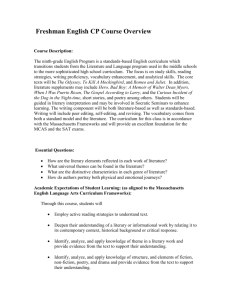
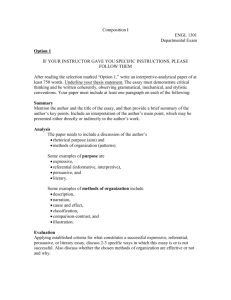
![Submission 68 [doc]](http://s3.studylib.net/store/data/008000926_1-fed8eecce2c352250fd5345b7293db49-300x300.png)
